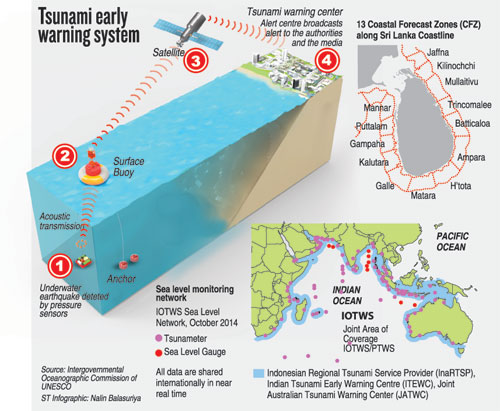News
Tsunami alarm network makes island feel safe than sorry

Prof. Samantha Hettiarachchi
Sri Lanka will never be fully protected from a tsunami, but at least people can feel safer than in 2004, when 36,000 Sri Lankans who perished had not been warned even though they had a two-hour window to reach higher ground.
This week, on December 26, 2004, Sri Lanka along with many other Asian nations, was hit by a tsunami that killed more than 200,000 people. The mammoth wave was generated by an undersea earthquake off Sumatra Island and it took two hours to reach the southern and eastern shores of Sri Lanka.
“Unlike in the past, Sri Lanka is now equipped to issue an early warning in a short period of time,” assures Anusha Warnasuriya, the deputy director of forecasting at the Department of Meteorology. It is responsible for issuing tsunami warnings. An accurate forecast can be made with the assistance of the Indian Ocean Tsunami Warning and Mitigation System (IOTWMS), she said.
By 2004, other oceanic regions already had a tsunami warning system. But the Indian ocean region did not have such a mechanism. So the Indian Ocean Tsunami Warning System was agreed to at a United Nations conference in January 2005. The Indian Ocean Tsunami Warning and Mitigation System became operational in late June 2006 with the leadership of UNESCO’s Intergovernmental Oceanographic Commission (IOC).
A Sri Lankan expert made a major contribution to the warning system.
Moratuwa University Department of Civil Engineering Professor Samantha Hettiarachchi was elected vice chairman of the IOTWMS in 2015 and in October 2016 appointed acting chairman.
“This warning system consists of several seismographic stations relaying information and Deep-ocean Assessment and Reporting of Tsunami buoys that are capable of sensing an upcoming tsunami wave. By also assessing rises in sea-level recorded by the tidal wave gauges, the computer simulation models in regional tsunami service providers can predict of a tsunami,” Prof Hettiarachchi explained.
Currently India, Indonesia and Australia serve as regional TSPs and when an earthquake occurs, the central agency of each country receives an alert. “TSPs issue warnings only to designated bodies and not to other agencies or the public. In Sri Lanka, the met department and the Disaster Management Centre receives information about a tsunami. The met department is the official designated body to receive and disseminate information in consultation with the Disaster Management Centre,” Prof Hettiarachchi elaborated.
The met department’s Warnasuriya said alerts are received from all three TSPs. “Assessing all these warning issued by IOTWMS, our director general in consultation with other stakeholders take a quick decision to issue a warning according to the risk level. The rest of the ground level work such as evacuations are then mainly taken care of by the Disaster Management Centre,” she said.
Since 2005, the met department has been tasked with being the central agency to receive tsunami alerts.
Sri Lanka is separated into 13 coastal forecast zones and sirens have been setup at highly vulnerable places. Tsunami-related evacuation drills had been done on March 29, 2005, September 17, 2007, and April 11, 2012.
“Education, awareness, preparedness, early warning, and response at the country level is essential. Evacuation plans, too, need to be clear. Regular drills are important,” Prof Hettiarachchi advises.
He points out that Sri Lanka is definitely safer against a tsunami threat than in 2004. But due to the nature of the tsunami threat Sri Lanka can never be completely safe, so the island must remain vigilant, he added.
Sri Lanka had been slow to conduct national vulnerability studies, but it is an exercise that can help to save lives and property, Prof Hettiarchchi recommended.
He also points out need to protect natural coastal ecosystems such as mangroves, coral reefs and sand dunes to help minimise potential damage from tsunami and other ocean waves.

| Multiple tools used to warn of tsunami All mobile phone users can be alerted by text messages in the event of a tsunami, a disaster management official says. This is in addition to a warning towers in coastal areas. “Now we have setup 77 tsunami warning towers covering the most vulnerable coastal areas of Sri Lanka. There is also one on Delft islands and these can be remotely activated to issue a warning with a siren and message in all three [main] languages,” said Pradeep Kodippili, the deputy director of the Disaster Management Centre. “But tsunami towers are only one mode of disseminating information to the public.’’ The centre said it has set up a network linking all the key government agencies and assigned pre-defined tasks to be able to act quickly. “We have our own radio frequencies to communicate with all the key agencies and also have the ability to issue an SMS similar to the ones issued by the President to all mobile users,’’ Kodippili said. “The centre also has a vehicle equipped with communications channels and other necessities, so even if our building is damaged, we are in a position to coordinate management of a disaster,’’ he added. Any person can register with the centre’s alert system by dialling #117 and by following the instructions. An app called ‘Disaster Early Warning Network – DEWN’ can also be downloaded. |

